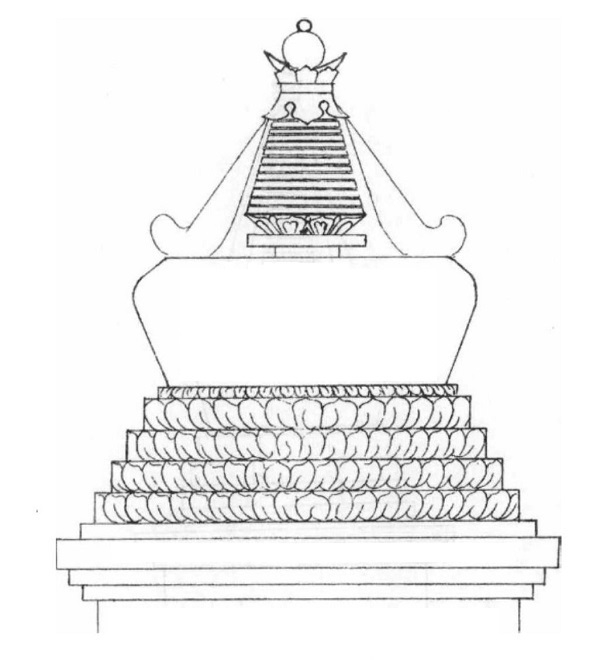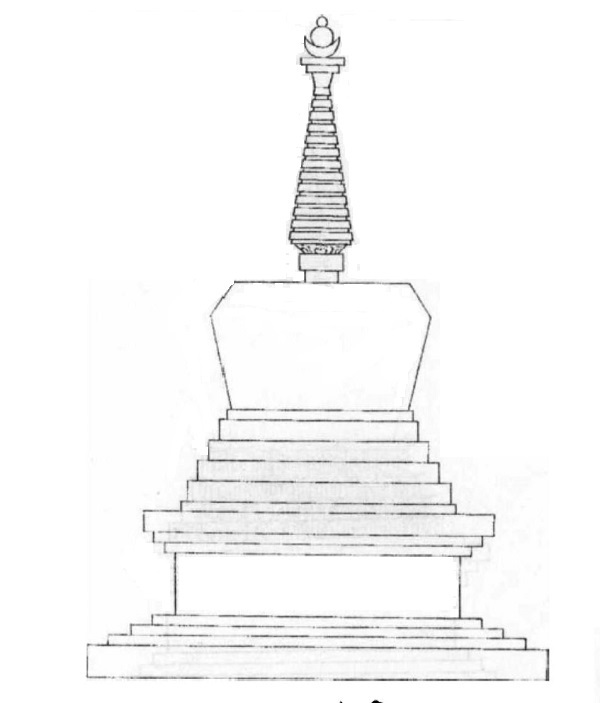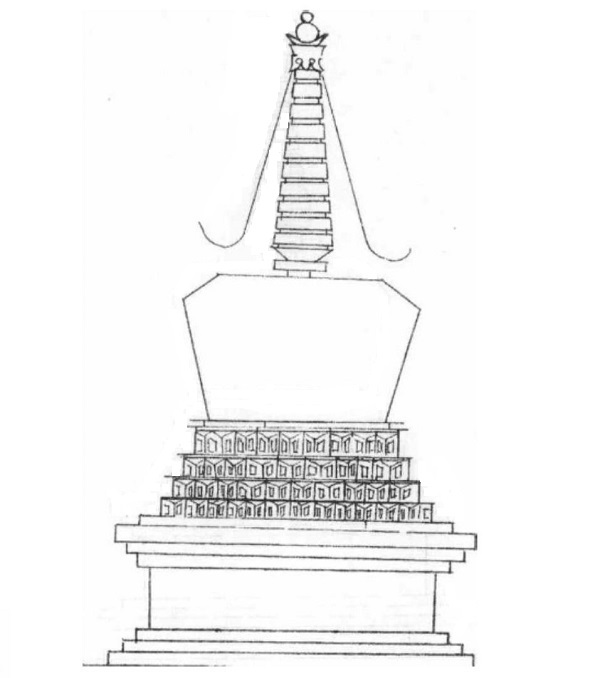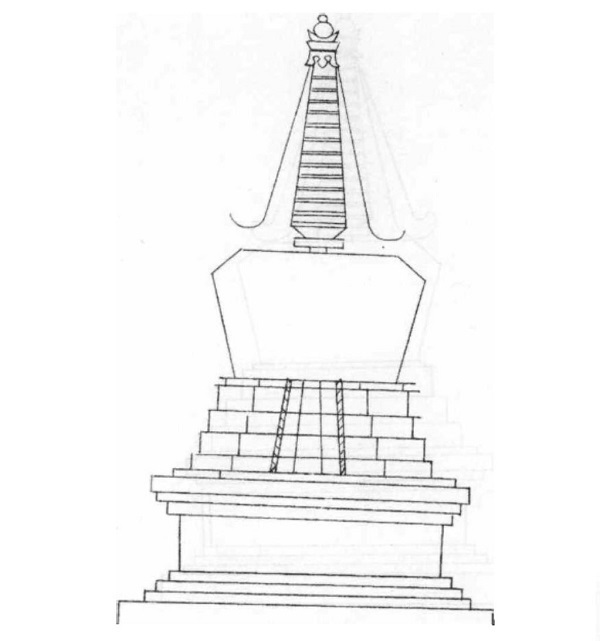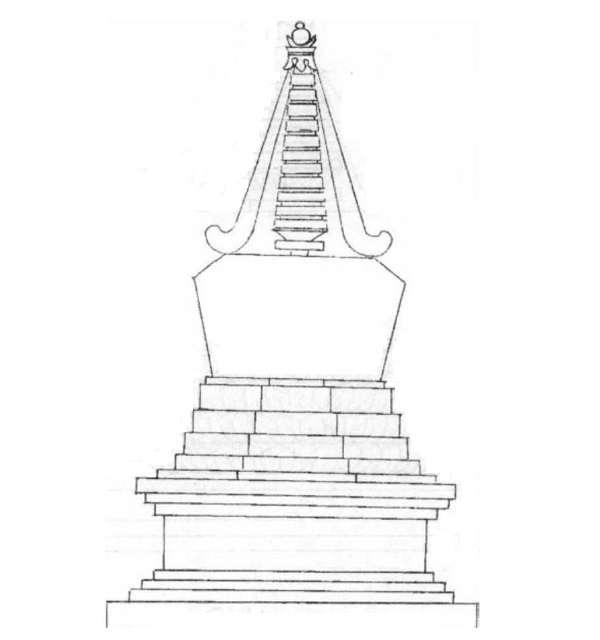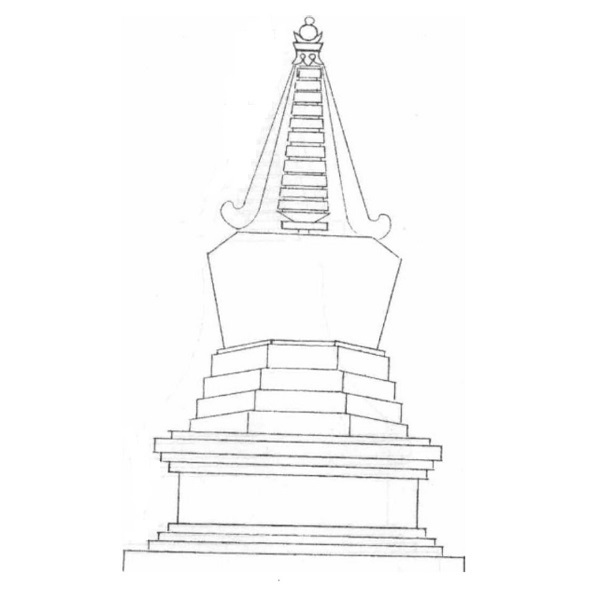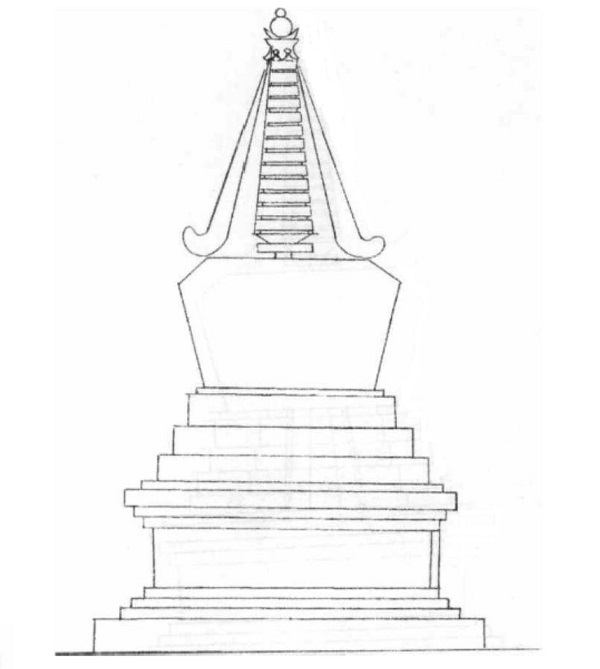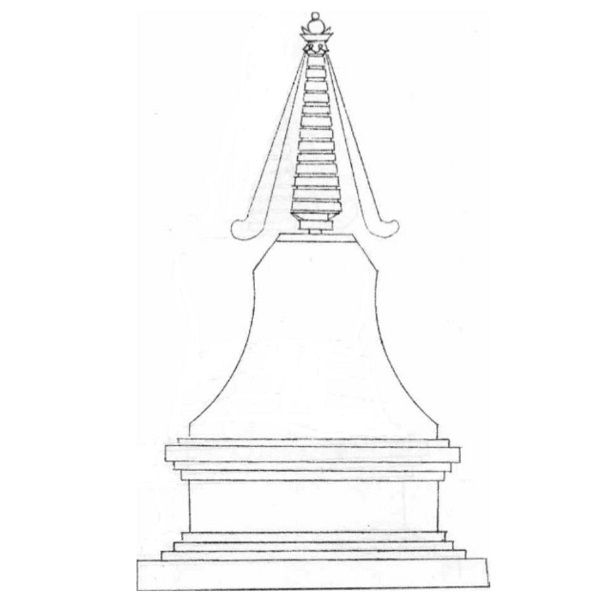Tibetan Stupa and Chorten
- by Catherine
- Last Updated: 2023-10-03
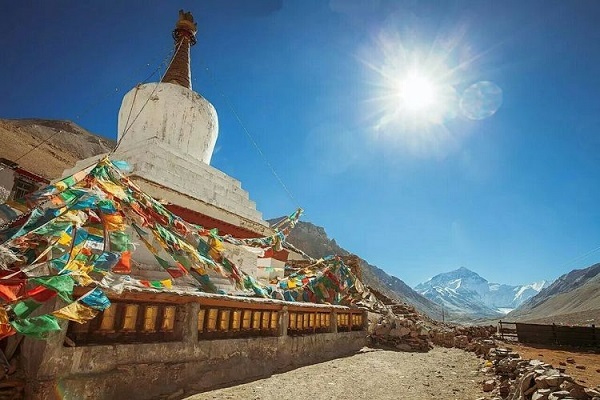 Stupa(Sanskrit) or Chorten(Tibetan)is a mound-like structure for collecting the Buddhist relics even preserved bodies of renowned lamas, symbolizing Buddha's presence. According to Buddhist scriptures, Shakyamuni personally taught his disciple Ananda Thera the method and specifications of building the stupa by stacking the Buddhist robes as a four-layer square and covering them with a bowl and a tin stick on top. In Tripitaka, there are many sutras about the specifications and significance of building a stupa, as well as the merits of building a stupa and circumambulating a stupa.
Stupa(Sanskrit) or Chorten(Tibetan)is a mound-like structure for collecting the Buddhist relics even preserved bodies of renowned lamas, symbolizing Buddha's presence. According to Buddhist scriptures, Shakyamuni personally taught his disciple Ananda Thera the method and specifications of building the stupa by stacking the Buddhist robes as a four-layer square and covering them with a bowl and a tin stick on top. In Tripitaka, there are many sutras about the specifications and significance of building a stupa, as well as the merits of building a stupa and circumambulating a stupa.
Stupas in Tibetan Buddhism and Theravada Buddhism, as well as stupas prevalent in ancient India and Japan, were almost built according to the specifications, proportions and expressions of sutras, which represent Trikaya, Trailokya, and the “five elements” (Earth, Water, Fire, Wind, and Void). Inside the cylinder part of a stupa, there enshrines the Buddhist relics of saints, sutra scripts, and various Buddhist sacred items. So Buddhists gain merits while circulating around a stupa or offering to a stupa.
Origin of Stupa
According to historical records, after the death of ancient Indian kings, they all built hemispherical tombs, which were said to be the prototype of a stupa.
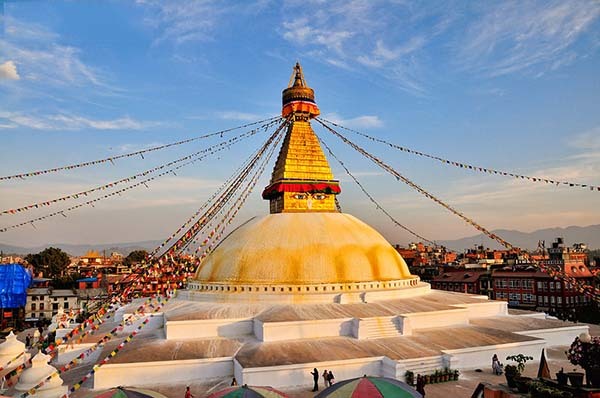 Later, after Buddha Shakyamuni passed away, the believers cremated his body to collect the relics of the body and built a tower-shaped tomb with the relics to commemorate the Buddha, which is regarded as the origin of the Buddhist stupa. Buddhist stupa nowadays in Tibet are derived from such tower-shaped architecture and have gradually developed.
Later, after Buddha Shakyamuni passed away, the believers cremated his body to collect the relics of the body and built a tower-shaped tomb with the relics to commemorate the Buddha, which is regarded as the origin of the Buddhist stupa. Buddhist stupa nowadays in Tibet are derived from such tower-shaped architecture and have gradually developed.
According to the historical monograph of the Yarlung dynasty recorded that the Buddhist Chorten was introduced to Tibet during the reign of King Lha Thothori Nyan Btsan (around the 4th century A.D.). Later scholars believed this was the time when Buddhism first arrived in Tibet. If it counts from that time, the stupa in Tibet has a history of more than 1,600 years.
Tibetans believe that the construction of various Buddhist Chortens is an act of accumulating merits. In the Tibetan area, not only Tibetan monks but also ordinary people build Chortens, which make Tibet one of the gathering places with the most stupas in the world.
Eight Types of Chorten in Tibetan Buddhism
In order to commemorate the eight major events in the Buddha Shakyamuni's life, eight different types of stupas were built at eight locations.
1 Lotus Blossom Stupa
The Lotus Blossom Stupa, also known as Stupa of Heaped Lotuses, symbolizes the birth of Buddha Shakyamuni. The Buddha was born in Lumbini in the North of ancient India(Kapilavastu town of Nepal today). It's said after his birth, Buddha took seven steps in four directions, with each step, a lotus flower sprang up. The father King Suddhodana and the Shakyas built a stupa for this purpose. The four layers of the stupas were round, and the layers were decorated with lotus petals.2 Enlightenment Stupa
The Enlightenment Stupa, also known as Bodhi Stupa, symbolizes Buddha's attainment of enlightenment under the bodhi tree. It's said when Buddha was 35 years old, he sat cross-legged facing the east under the Vajra Bodhi tree in ancient India. After seven days and seven nights of contemplation and meditation, he finally enlightened and became a Buddha. Bimbisara built a four-layer stupa for this purpose.3 Stupa of Many Doors
This stupa commemorates the event when Shakyamuni Buddha first taught his five disciples the Four Noble Truths in Deer Park near Sarnath 49 days after reaching enlightenment. The five Buddhist monks built a four-layer stupa with multiple doors in each layer and direction.4 Stupa of Descent from the God Realm
Soon after the birth of Prince Siddhartha, his mother died of illness and was reborn in heaven because of her good karma. After the prince became a Buddha, he ascended to heaven at the age of 42 to teach his mother dharma in order to repay her kindness. After preaching, Buddha descended from heaven to earth. This stupa was built with a ladder to commemorate Buddha's descending from heaven to earth after preaching.5 Stupa of Great Miracles
Stupa of Great Miracles, also known as Stupa of Conquest of the Tirthikas, refers to various miracles performed by the Buddha when he was 50 years old. Once there were "Six Heretical Teachers", each of them held a view in opposition to the Buddha's teachings and challenged Buddha in Shravasti. However, Gautama Buddha eventually made them convinced and converted to Buddhism. This stupa was built with a prominent middle part to commemorate Buddha's supernatural power.6 Stupa of Reconciliation
This stupa commemorates the Buddha's efforts in solving the splitting among the monastic sects. Once there were disciples who set up another sect, which led to the division of the Sangha. The Buddha went to Venuvana Vihara (the first Buddhist monastery in Rajgir, India) to give talks to reconcile them and, finally, unite the Sangha again. This 4-level octagonal stupa was built for this purpose.7 Stupa of Complete Victory
This stupa was built to commemorate Buddha's extension of his life by three months when his followers pleaded for him to stay. This three-level circular stupa was built for this purpose.8 Stupa of Nirvana
When the Buddha was 81 years old, he was facing north outside the city of Kushinagar, with his right hand supported, facing the west, lying sideways, and attained Nirvana.
This stupa commemorates that Buddha attained Nirvana in Kushinagar when his body was eighty years old. It represents Buddha achieving a state of true peace, and releasing from the rebirth cycle. This stupa was built bell-shaped.
Tibetan Stupas
Tibetan stupa is an important part of the Buddhist stupa. It is a fusion of Buddhist stupa and Tibetan architecture, which is unique to Tibetan Buddhism. Tibetan stupa evolved from the monument built by Buddhists after the Nirvana of Buddha Shakyamuni in India.
 The time when the Tibetans built such stupas began in the 9th to 10th centuries. When eminent Buddhist monks and gurus passed away, their bodies were completely preserved in stupas after special treatment. For example, after the death of King Lhalama Yeshe ö (966-1036) of the Kingdom of Guge, his body was preserved in a Tibetan stupa. The remains of Je Tsongkhapa (1357–1419), the founder of the Gelug school of Tibetan Buddhism, were enshrined in a Tibetan stupa in Ganden Monastery. The body of the 4th Panchen Lama (1570–1662) was also preserved in a stupa in Tashilhunpo Monastery. And after the Dalai Lamas passed away since the 5th Dalai Lama (1617–1682), except the sixth, their bodies were all enshrined in the stupas of Lhasa Potala Palace.
The time when the Tibetans built such stupas began in the 9th to 10th centuries. When eminent Buddhist monks and gurus passed away, their bodies were completely preserved in stupas after special treatment. For example, after the death of King Lhalama Yeshe ö (966-1036) of the Kingdom of Guge, his body was preserved in a Tibetan stupa. The remains of Je Tsongkhapa (1357–1419), the founder of the Gelug school of Tibetan Buddhism, were enshrined in a Tibetan stupa in Ganden Monastery. The body of the 4th Panchen Lama (1570–1662) was also preserved in a stupa in Tashilhunpo Monastery. And after the Dalai Lamas passed away since the 5th Dalai Lama (1617–1682), except the sixth, their bodies were all enshrined in the stupas of Lhasa Potala Palace.
Some other Tibetan stupas contain the ashes of Buddhist monks instead of their preserved bodies.
Tibetan stupa embodies a unique form of Tibetan funeral. It holds a lofty status in the hearts of the Tibetan Buddhists. Most Tibetan monasteries enshrine various stupas. Here're some famous Tibetan stupas,
Stupa in Tradruk Temple
A Tibetan classic writes that Tibetan King- Songtsen Gampo (?- 650 A.D.) built a five-pointed Buddhist Chorten in Tradruk Temple. This is the first Tibetan stupa recorded in historical data.
Stupa in Samye Monastery
Samye Monastery is the first Tibetan Buddhist temple with Triratna (Buddha, Dharma, Sangha). Four Chortens in colors of white, red, black, and green were built in four corners. There are 1,008 small Chortens on the surrounding walls of Samye Monastery, and various forms of towers were built further away from the temple.
Stupa in Pelkor Chode Monastery
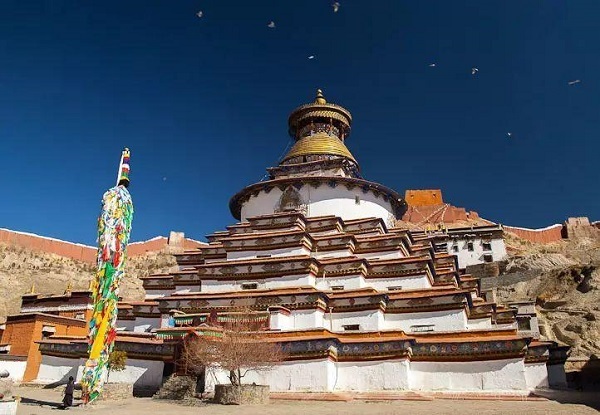 The stupa is popularly called "Kumbum', a symbol of Gyantse. It is actually a fusion of a monastery and a Tibetan stupa. There are 77 chapels and shrines of the same size in the pagoda and walkway lined by prayer wheels. It is also given the name “the Ten Thousand Buddha Pagodas”, as it has enshrined a hundred thousand figures of Buddhas as images and murals.
The stupa is popularly called "Kumbum', a symbol of Gyantse. It is actually a fusion of a monastery and a Tibetan stupa. There are 77 chapels and shrines of the same size in the pagoda and walkway lined by prayer wheels. It is also given the name “the Ten Thousand Buddha Pagodas”, as it has enshrined a hundred thousand figures of Buddhas as images and murals.
Stupa in Potala Palace
There are eight stupas built in Potala Palace.
The shining golden dome on the top of the Potala Palace is where the spiritual stupas of the eight Tibetan Dalai Lamas were located.
Stupa in Tashilhunpo Monastery
In Tashilhunpo Monastery, there is a stupa built to contain the remains of the 1st Dalai Lama, Gedun Drupa (1391-1474), and the bodies of successive Panchen Lamas.
Related Articles
- Tibetan Buddhism Prostration - How and Why to Make Prostrations
- Tibetan Sky Burial Custom
- Tibetan Vacation
- Namseling Manor
- Wenshu Monastery
- Boudhanath Stupa
- Leshan Giant Buddha
- Lhoka Travel Guide
- Gossul Monastery
- Tashi Lhunpo Monastery
Email response within 0.5~24 hours.


